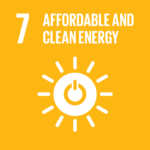In India, the impact of Decentralized Renewable Energy (DRE) on rural communities is particularly noteworthy.
Decentralized Renewable Energy (DRE) stands at the forefront of the global push for universal energy access and a cleaner energy future. DRE systems, varying from solar lanterns and biomass stoves to solar home systems and mini-grids, generate, store, and distribute power locally, offering a sustainable solution to energy needs across urban and rural landscapes alike.
RELEVANT SUSTAINABLE GOALS



In India, the impact of DRE on rural communities is particularly noteworthy. Solar solutions light up millions of lives, while innovative agricultural applications and urban solar rooftops demonstrate DRE’s versatility. The country’s thriving off-grid solar market, with 1.3 million products sold in just half of 2018, underscores the potential of targeted DRE initiatives. R.P. Gupta of the Solar Energy Corporation of India Limited hails DRE as a crucial answer to energy challenges, highlighting its role in achieving Sustainable Development Goal 7 (SDG7) – affordable, reliable, sustainable, and modern energy for all by 2030.
Despite progress, challenges remain, with an estimated 660 million people projected to lack electricity access by 2030. DRE technologies not only bridge this gap but also advance health, education, employment, gender inclusion, and mental well-being, marking a significant leap from 35 million to 179 million people gaining electricity access through DRE from 2012 to 2021.
Empowering Marginalized Communities Through Decentralized Renewable Energy (DRE)
A groundbreaking study by the Council on Energy, Environment, and Water (CeeW) reveals the transformative power of decentralized renewable energy (DRE) technologies. With a market opportunity surpassing $50 billion, these innovations are poised to revolutionize livelihoods in India, particularly for marginalized communities. DRE technologies, such as solar silk reeling and spinning machines and micro solar pumps, are not just tools for sustainable energy—they are vehicles for resilience, sustainability, and empowerment.
Remarkably, women are the primary beneficiaries of these technologies, with 92% of solar silk machine users and 65% of micro solar pump users being female. This significant participation underscores the pivotal role DRE plays in fostering economic independence for women and increasing productivity in specialized tasks.
The journey to widespread DRE adoption is a collaborative one, with government initiatives like the Pradhan Mantri Kisan Urja Suraksha Evam Utthan Mahabhiyan (PM KUSUM) scheme offering crucial support. Meanwhile, the private sector and partnerships, such as the Jharkhand Opportunities for Harnessing Rural Growth (JOHAR) project, exemplify the successful integration of DRE solutions into agricultural practices, especially benefiting tribal women farmers.
However, the path to universal DRE adoption faces hurdles, including the initial high costs and the lack of technical expertise and infrastructure in rural areas. Overcoming these challenges requires government support, innovative financing solutions, and comprehensive capacity-building efforts.
The impact of DRE technologies is undeniable. CeeW’s findings show a 35% income increase among 71% of users, illustrating the significant economic uplift these technologies provide. Furthermore, women users report enhanced community involvement and skill development, highlighting DRE’s role in promoting gender equality and empowering women in India’s rural areas.
Initiatives such as the Rajasthan Grameen Aajeevika Vikas Parishad (Rajeevika) exemplify efforts to make these technologies financially accessible, offering substantial subsidies and credit assistance for women to purchase DRE solutions. Additionally, women’s self-help groups provide crucial financial support, enabling the adoption of DRE without the need for collateral.
You may also be interested in :
Green Revolution In Asia : Transitioning Towards A Sustainable Future


